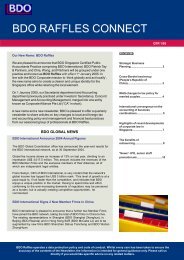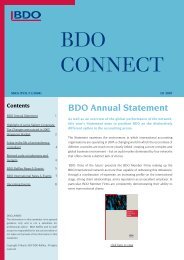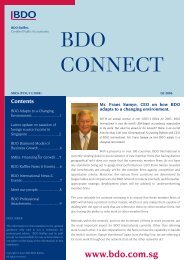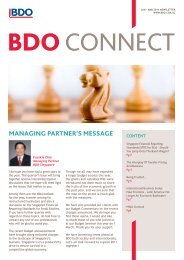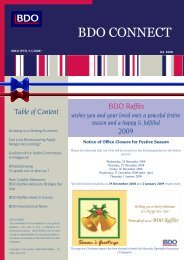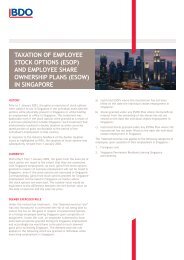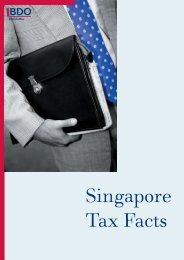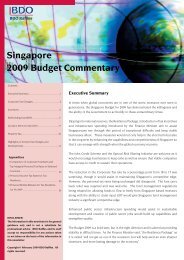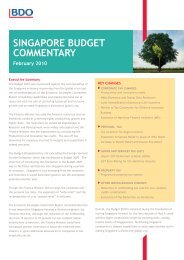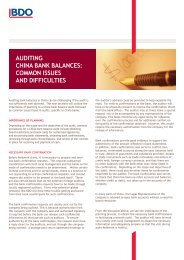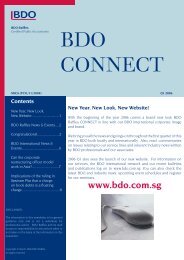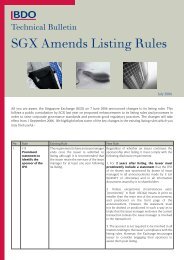Illustrative Financial Statements 2011 - bdo singapore
Illustrative Financial Statements 2011 - bdo singapore
Illustrative Financial Statements 2011 - bdo singapore
You also want an ePaper? Increase the reach of your titles
YUMPU automatically turns print PDFs into web optimized ePapers that Google loves.
ABC SINGAPORE LIMITED AND ITS SUBSIDIARIES<br />
NOTES TO THE FINANCIAL STATEMENTS<br />
FOR THE FINANCIAL YEAR ENDED 31 DECEMBER <strong>2011</strong> (Continued)<br />
FRS 1: 112, 117<br />
2. Summary of significant accounting policies (Continued)<br />
2.5 Borrowing costs<br />
FRS 23: 8<br />
FRS 23: 12<br />
FRS 23: 15<br />
FRS 23: 8<br />
Borrowing costs directly attributable to the acquisition, construction or production of<br />
qualifying assets, which are assets that necessarily take a substantial period of time to get<br />
ready for their intended use or sale, are added to the cost of those assets, until such time<br />
as the assets are substantially ready for their intended use or sale. Borrowing costs on<br />
general borrowings are capitalised by applying a capitalisation rate to construction or<br />
development expenditures that are financed by general borrowings. Investment income<br />
earned on the temporary investment of specific borrowings pending their expenditure on<br />
qualifying assets is deducted from the borrowing costs eligible for capitalisation.<br />
All other borrowing costs are recognised in profit or loss in the period in which they are<br />
incurred.<br />
2.6 Retirement benefit costs<br />
FRS 19: 44<br />
Payments to defined contribution retirement benefit plans are charged as an expense as<br />
they fall due. Payments made to state-managed retirement benefit schemes, such as the<br />
Singapore Central Provident Fund, are dealt with as payments to defined contribution<br />
plans where the Group’s obligations under the plans are equivalent to those arising in a<br />
defined contribution retirement benefit plan.<br />
2.7 Employee leave entitlements<br />
FRS 19: 11<br />
Employee entitlements to annual leave are recognised when they accrue to employees. A<br />
provision is made for the estimated liability for annual leave as a result of services<br />
rendered by employees up to the end of the financial year.<br />
2.8 Income tax<br />
Income tax expense represents the sum of the tax currently payable and deferred tax.<br />
FRS 12: 5<br />
FRS 12: 46<br />
FRS 12: 5<br />
FRS 12: 15<br />
FRS 12: 24<br />
The tax currently payable is based on taxable profit for the year. Taxable profit differs<br />
from profit as reported profit or loss because it excludes items of income or expense that<br />
are taxable or deductible in other years and it further excludes items that are not taxable<br />
or tax deductible. The Group’s liability for current tax is calculated using tax rates (and<br />
tax laws) that have been enacted or substantively enacted in countries where the<br />
Company and subsidiaries operate by the end of the financial year.<br />
Deferred tax is recognised on the differences between the carrying amounts of assets and<br />
liabilities in the financial statements and the corresponding tax bases used in the<br />
computation of taxable profit, and are accounted for using the balance sheet liability<br />
method. Deferred tax liabilities are generally recognised for all taxable temporary<br />
differences and deferred tax assets are recognised to the extent that it is probable that<br />
taxable profits will be available against which deductible temporary differences can be<br />
utilised. Such assets and liabilities are not recognised if the temporary difference arises<br />
from goodwill or from the initial recognition (other than in a business combination) of<br />
other assets and liabilities in a transaction that affects neither the taxable profit nor the<br />
accounting profit.<br />
Deferred tax liabilities are recognised on taxable temporary differences arising on<br />
investments in subsidiaries and associates, and interests in joint ventures, except where<br />
the Group is able to control the reversal of the temporary difference and it is probable<br />
that the temporary difference will not reverse in the foreseeable future.<br />
36 | P a g e



